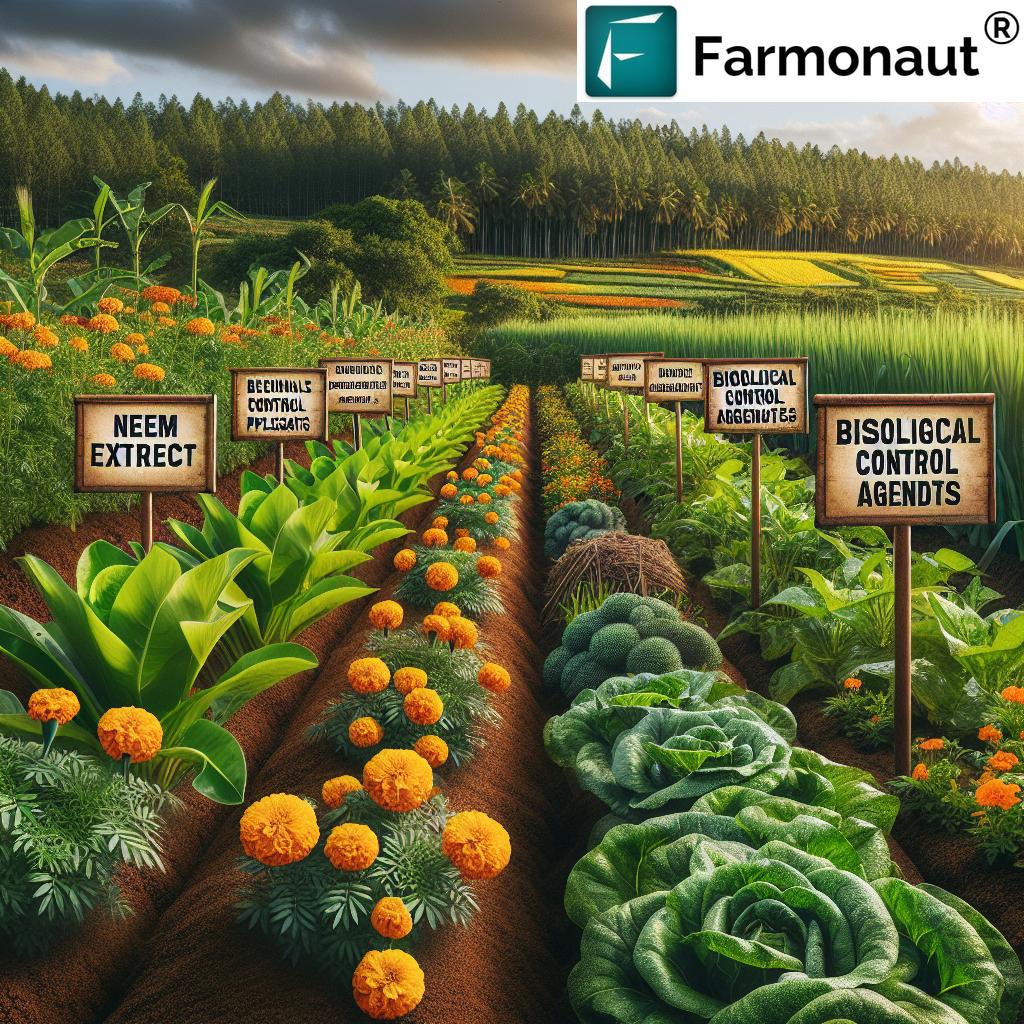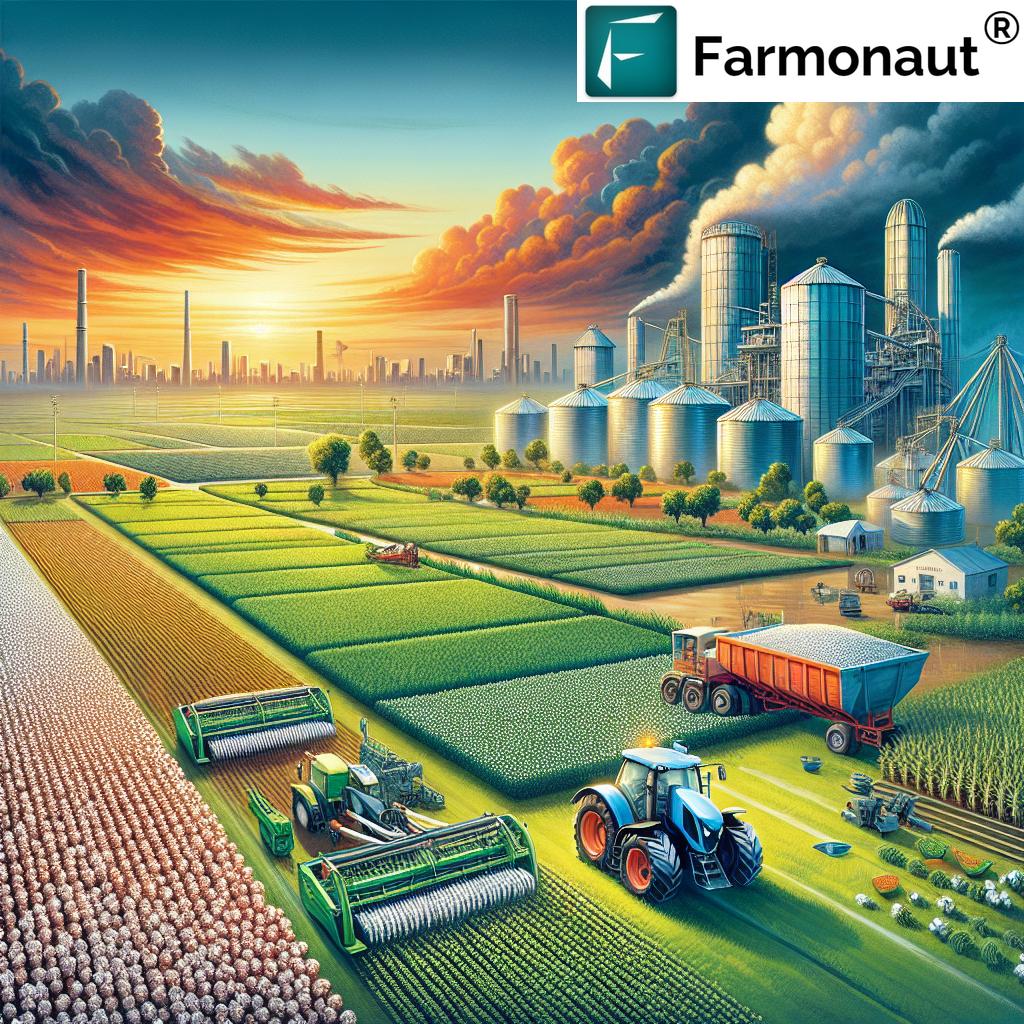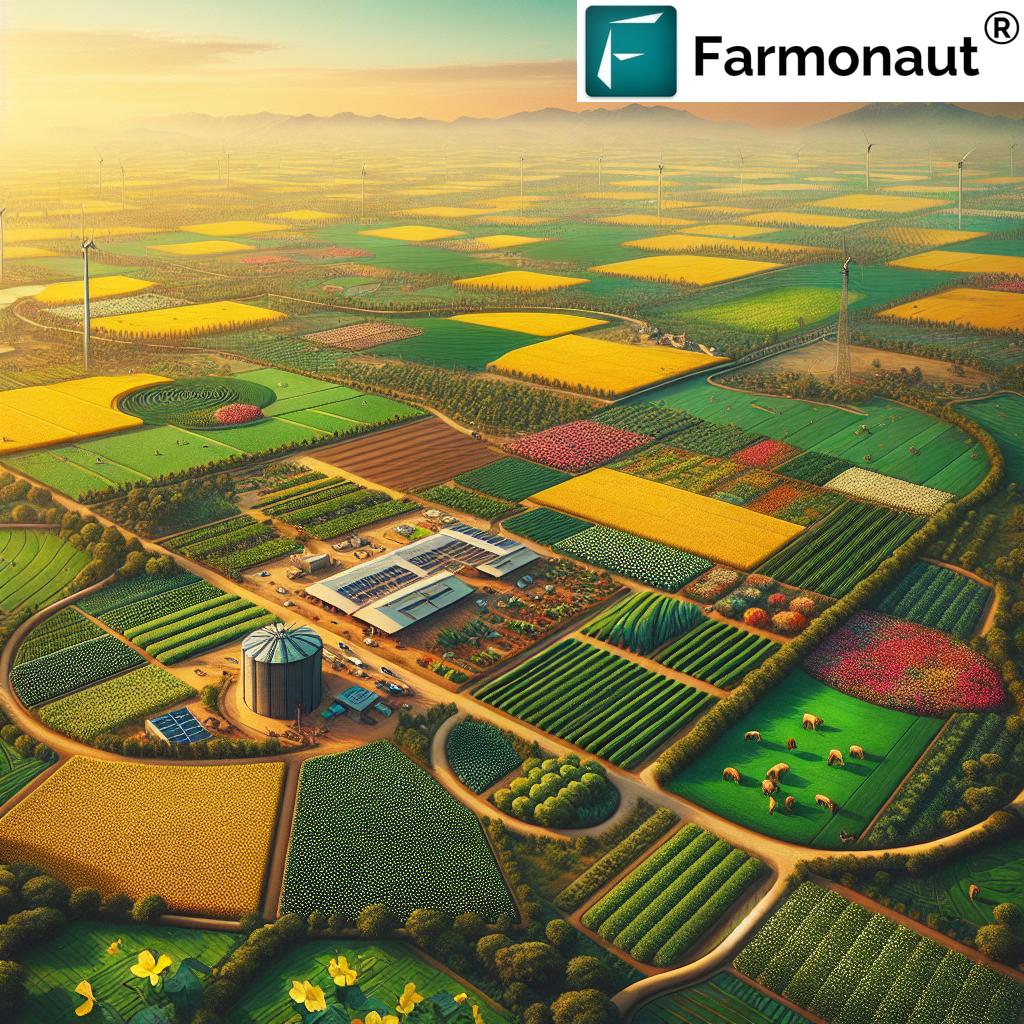Farmland Classification & Agriculture Land Use in India: A Comprehensive Overview for 2025
“Over 60% of India’s land is classified as agricultural, supporting advanced farming systems projected to increase by 2025.”
Table of Contents
- Introduction
- Farmland Classification: A Foundation for Planning
- Comparative Classification Table: Farmland & Agriculture Land Use India 2025
- Agriculture Land Use Classification in India
- Types of Agriculture Classification in India
- Classification of Farming Systems
- Classification of Agriculture Finance
- Technology & Policy Reforms Shaping the Future
- How Technology Like Farmonaut Accelerates Agricultural Classification
- Essential Videos on Farmland Classification & Innovation
- Frequently Asked Questions (FAQ)
- Conclusion
- Farmonaut Subscription Tools
Introduction: A Holistic View on Farmland Classification & Agricultural Land Use Classification in India
Agriculture remains the backbone of India’s economy, supporting the livelihoods of nearly 60% of the population. Understanding farmland classification and agriculture land use classification in India is crucial for optimizing resource allocation, improving productivity, and ensuring sustainable development. As India progresses towards 2025, advances in technology, ongoing policy reforms, and rapidly changing climatic conditions are reshaping our country’s agricultural landscape.
Through this comprehensive overview, we explore:
- Farmland classification—the foundation for strategic planning.
- Agriculture land use classification in India—revealing patterns and priorities.
- Types of agriculture classification—showcasing diversity.
- Classification of farming systems—highlighting localized solutions.
- Classification of agriculture finance—driving growth and resilience.
By integrating focus keywords naturally, and addressing the synergy of technology and policy reforms, this article delivers an actionable perspective for 2025 and beyond.
Farmland Classification: A Foundation for Strategic Planning
Farmland classification refers to the systematic categorization of agricultural land in India based on its physical, chemical, and socio-economic characteristics. This classification acts as a foundation for efficient planning, management, crop selection, and investment decisions. Policymakers and farmers both benefit from understanding different land classes, helping to ensure sustainable agricultural development, productivity, and optimization of resources.
Major Criteria for Farmland Classification in India
-
Soil Type:
- Alluvial soils (Indo-Gangetic Plains, Assam, Punjab): Extremely fertile, well-suited for intensive cropping (e.g., rice, wheat, sugarcane).
- Black soils (Deccan Plateau, Maharashtra, Madhya Pradesh, Gujarat): Rich in clay, ideal for cotton, pulses, and oilseeds.
- Red soils (Tamil Nadu, Karnataka, Odisha, Southeast India): Moderately fertile, suitable for groundnut, millets, and pulses.
- Laterite soils (Kerala, Western Ghats, Northeast): Accommodate plantation crops—rubber, tea, coffee—require careful nutrient management.
- Desert soils (Rajasthan, Gujarat): Low fertility, need robust irrigation and soil conservation practices.
-
Topography:
- Plains: Enable large-scale mechanization, high input use, efficient irrigation deployment.
- Slopes and hill areas: Require terracing, careful erosion management, and are less suited to heavy machinery.
-
Irrigation Facilities:
- Classifying lands as irrigated or rainfed affects cropping intensity, risk management strategies, and potential for double/triple cropping.
-
Land Capability Classes:
- Class I–IV: Class I is the most fertile and least erosion-prone, supporting intensively farmed operations. Class IV and beyond require protected or limited exploitation due to fragility or risk.
Through such classification, fragile lands can be protected against degradation while high-yielding lands are optimized for increased productivity.
Comparative Classification Table: Farmland & Agriculture Land Use India 2025
Farmland classification and agriculture land use classification in India are evolving rapidly, especially with projections for 2025. The following table presents a side-by-side comparative overview, highlighting major categories, estimated shares, and the impact of technological and policy innovation.
| Classification Type | Description | Est. % Share (2025) | Technological Innovations Adopted | Policy Reforms | Key Fintech Applications |
|---|---|---|---|---|---|
| Net Sown Area | Land sown with crops during the year (once or more) | 45% | Satellite crop monitoring, AI-based advisory, precision agriculture | Digital land records, direct benefit transfer (DBT), PM-KISAN | Credit scoring, digital lending (see crop loan/insurance tools) |
| Gross Cropped Area | Total area sown, including multiple cropping | 56% | Remote sensing, multi-temporal NDVI analysis | MSP reforms, crop diversification incentives | Digital payout tracking, crop insurance APIs (Farmonaut API) |
| Fallow Land | Temporarily or permanently uncultivated agricultural land | 7% | Satellite barren/unused land maps, restoration analytics | Land rejuvenation programs, MNREGA targeting | Climate-adaptive loans, restoration grants |
| Permanent Pasture & Grazing Land | Areas reserved for livestock grazing, not crop production | 4% | Livestock health monitoring, smart pasture management using IoT/satellite | Livestock insurance schemes, fodder bank initiatives | Insurance underwriting, livestock asset tracking |
| Tree Crops & Groves | Land under orchards, plantations (coconut, rubber, coffee) | 5% | Satellite yield est., disease mapping | Agroforestry promotion, carbon farming credits (See carbon footprinting) | Traceability, carbon credits marketplace (See traceability tech) |
| Wasteland | Degraded, under-utilized areas not suited for agriculture | 9% | Land reclamation analytics, GIS-based suitability assessment | Wasteland development, Green India Mission | Restoration finance, monitoring grants |
| Other/Non-Agricultural Land | Lands under buildings, infrastructure, industries, settlements | 14% | Land use change detection, infrastructure mapping | Urban/rural land zoning, smart city initiatives | Geo-fencing for loan eligibility, risk analytics |
“By 2025, policy reforms aim to digitize land use records for 140 million Indian farms, driving technological innovation.”
Agriculture Land Use Classification in India: Pattern and Distribution
Agriculture land use classification in India reveals how land is distributed among different agricultural and non-agricultural categories. This pattern informs planning, aids in resource management, and guides policy interventions—especially in the context of 2025’s demands for sustainable growth and climate resilience.
Major Land Use Categories:
- Net Sown Area: Consistently the largest category, highlighting the centrality of crop production.
- Gross Cropped Area: Indicates cropping intensity—regions like Punjab, Haryana, and Uttar Pradesh consistently top this metric, often double or triple cropping.
- Fallow Land: Encompasses both current fallows (left uncultivated for one or two years) and permanent fallow (abandoned from cultivation for 5+ years).
- Permanent Pastures and Grazing Lands: Important for the livestock sector, concentrated in arid and semi-arid zones like Rajasthan.
- Tree Crops & Groves: Significant in Kerala (coconut, rubber), Karnataka, Assam (tea), and the Western Ghats (spices).
- Wasteland: Encompasses degraded, saline, or otherwise unproductive soils—target areas for reclamation and climate smart solutions.
- Built-up/Non-agricultural Land: Grows steadily with urbanization—needs policy safeguards to maintain agricultural sustainability.
Understanding this classification ensures optimal planning, climate risk mitigation, and effective targeting of technological interventions for the years ahead.
Types of Agriculture Classification in India: Identifying Diversity
Types of agriculture classification highlight the diversity of farming practices and production systems across India’s vast regions. These classifications are essential for effective resource allocation, extension planning, and strategic investment, especially as new technology and climate-adaptive innovations transform the sector.
-
Subsistence Agriculture:
Practiced by small and marginal farmers, focused on self-consumption rather than surplus sales.
Example: Hilly regions of Uttarakhand, Northeast India. -
Commercial Agriculture:
Predominated by cultivation for the market, often large-scale with high input use and mechanization.
Example: Sugarcane in Uttar Pradesh, Cotton in Maharashtra, Oilseeds in Gujarat. -
Intensive Agriculture:
High labor and input intensity per unit area. Characteristic of areas with assured irrigation, such as Punjab and Haryana. -
Extensive Agriculture:
Lower input use and labor intensity. Favorable in regions with abundant land resources but marginal soils, e.g., Western Rajasthan. -
Mixed Farming:
Integrated systems combining crop cultivation and livestock rearing. Much of Central India and the Deccan follows this model. -
Plantation Agriculture:
Focus on perennials/plantations (tea, coffee, rubber) in the Western Ghats, NE states, Kerala, and Assam. -
Organic and Regenerative Agriculture (Emerging by 2025):
Fast-growing category in Uttarakhand, Sikkim, and other hill states. Supported by policy incentives, climate resilience benefits, and blockchain traceability solutions.
Each type responds to local soil, climate, topography, and market conditions, emphasizing the need for classification tools that integrate both traditional wisdom and modern data analytics.
Classification of Farming Systems in India: Systems Thinking for 2025
Classification of farming systems in India is pivotal for both farmers and policymakers. It considers the holistic integration of environmental, technical, and socio-economic factors, helping to identify the most appropriate and sustainable farming models for specific regions and challenges.
Recognized Major Farming Systems:
-
Rainfed Farming Systems:
Prevalent in Deccan Plateau, Telangana, Madhya Pradesh, Rajasthan. Rely on monsoons, need drought-resistant crops (Crop Plantation & Forest Advisory benefits). -
Irrigated Farming Systems:
Prominent in the Indo-Gangetic Plains, Punjab, Haryana, and deltaic regions of Kerala and Tamil Nadu. Facilitates high cropping intensity and multiple crop cycles. -
Hill & Mountain Farming Systems:
Himalayan states, North-East, and parts of Western Ghats. Features terrace cultivation, horticulture, and agroforestry; requires soil conservation strategies. -
Coastal Farming Systems:
Involves integration of crop, livestock, aquaculture, and sometimes mangrove conservation (e.g., Andhra Pradesh, Gujarat, Kerala coast). -
Arid and Semi-Arid Systems:
Western Rajasthan and Kutch—rely on rainwater harvesting, climate-smart solutions, and drought-adapted crops.
Adopting a farming systems approach helps tackle local challenges—from water scarcity to soil erosion and market access—and supports sustainable development goals for the future.
Empowering farmers with timely, regional guidance from AI and satellite tools (such as our API, and large-scale management platforms) enhances their capacity for resilience and productivity.
Classification of Agriculture Finance: Structured Credit to Power Growth
Classification of agriculture finance is integral for improving access to credit, supporting livelihoods, and ensuring agricultural productivity in India. Recognizing and delivering the right credit types according to land use and farming system boosts resilience and enables investment in technology and sustainable management.
-
Short-Term Credit:
- Pulled towards seasonal operations—seeds, fertilizers, pesticides, wages.
- Delivered through cooperative banks, rural credit societies, direct benefit platforms.
-
Medium-Term Credit:
- Fund investment in farm machinery, irrigation infrastructure, livestock acquisition.
- Often sourced from commercial banks and regional rural banks, now increasingly verified via satellite data (Farmonaut fleet/resource management supports asset tracking and credit underwriting).
-
Long-Term Credit:
- For land development, farm buildings, plantation establishment, and permanent irrigation systems.
- Backed by institutions like NABARD, insurance/satellite verification (loan and insurance analytics).
As fintech integrates with agriculture, satellite-driven verification and digital credit pipelines are driving the next phase of secure, timely, and inclusive agricultural finance.
How Technology & Policy Reforms are Reshaping Farmland Classification & Land Use in India (2025 & Beyond)
Rapid advances in technology—from satellite-based crop monitoring, real-time weather intelligence, and AI-driven risk assessment to blockchain traceability—are directly transforming classification systems in India. As policy reforms push for digitized land records, direct income support, and incentives for sustainable farming, the synergy between government action and technological innovation is more critical than ever.
- Digital Land Record Modernization: Government programs (like Digital India Land Records Modernization Program) aim to digitize titles for 140 million+ farms by 2025. This supports precision input delivery, direct transfers, and market linkage, ultimately boosting transparency and ease of doing business.
- Precision Agriculture: Tools such as NDVI imaging, AI-driven advisories, and resource use optimization are being rapidly adopted—even by smallholders, via platforms like Farmonaut.
- Fintech and Blockchain: Real-time loan/insurance verification minimizes fraud and expands credit access for farmers. Blockchain facilitates product traceability, a critical factor for India’s growing export markets.
-
Policy Support for Regenerative & Climate Resilient Farming: Policy moves like PM-KUSUM (solar irrigation), PM-Fasal Bima Yojana (insurance), and carbon/organic incentive frameworks are driving Indians towards adopting climate-smart and sustainable practices at scale.
See how carbon monitoring and regenerative systems fit in: India carbon footprinting technology
These dynamic shifts foster resource optimization, risk mitigation, and sustainable development—empowering Indian agriculture for 2025 and beyond.
How Technology Like Farmonaut Accelerates Agricultural Classification, Planning & Monitoring
At Farmonaut, we recognize the importance of accurate, scalable, and actionable data for effective farmland classification and agriculture land use classification in India. Our goal is to democratize satellite and AI-driven insights for every farmer, agribusiness, and policymaker.
Farmonaut’s platform provides:
- Satellite-Based Monitoring: Multispectral imagery to classify land use, monitor crop health, assess soil characteristics, and optimize irrigation across various regions.
- AI Advisory: Our Jeevn AI analyzes data for real-time farming strategies, tailored to each farming system—rainfed, irrigated, hill, or coastal.
- Blockchain Traceability: Secure, transparent traceability for products and resources, addressing the emerging needs for export certification and fraud prevention in the Indian agricultural supply chain. See product traceability details
- Fleet & Resource Management: Integrated solutions to monitor, deploy, and optimize irrigation/farm machinery, reducing operational costs. Access advanced fleet management tools here.
- Carbon & Environmental Monitoring: Real-time analytics on emissions, carbon footprint, and land use change—supporting sustainable planning and compliance. Discover our carbon footprinting platform.
- Fintech Integration: Satellite-verified assessment tools for banks and insurers, reducing fraud, and enabling digital lending and micro-insurance.
- Explore our crop loan & insurance solutions
- API Access & Mobile/Web Apps: For custom integration and on-the-go management. Developers and businesses can get started with our API documentation or via web/mobile apps.
Essential Videos on Farmland Classification & Innovation in Agriculture
-
Comprehensive Guide to Land Cover Classification:
Unlocking Farm Potential: A Comprehensive Guide to Land Cover Classification and Farm Land Types -
The Hidden Importance of Land Classification:
Why It Matters More Than You Think! -
How Our Satellite Technology is Revolutionizing Land Use:
Farmonaut’s Satellite Technology in Agriculture -
Farmonaut Web System Tutorial:
Monitor Crops via Satellite & AI -
Farmonaut For Crop Area Estimation:
Learn Crop Area with Satellite -
Large Scale Field Mapping:
Satellite Based Farm Monitoring in India -
Regenerative Agriculture 2025:
Carbon Farming, Soil Health & Climate-Smart Solutions | Farmonaut
Frequently Asked Questions (FAQ): Farmland & Agriculture Land Use Classification in India
-
What is farmland classification and why is it relevant for India in 2025?
Farmland classification is the systematic categorization of land based on soil, topography, irrigation facilities, and capability classes. It guides optimal land use, investment, and supports sustainable development. By 2025, it is increasingly used for digital planning, climate resilience, and financial innovation. -
How does technology like satellite monitoring help in agriculture land use classification in India?
Satellite monitoring enables real-time, accurate mapping of land use, crop health, and productivity zones. Platforms such as Farmonaut make this data actionable and affordable. -
What are the main types of agriculture classification in India?
The main types are: Subsistence, Commercial, Mixed, Intensive, Extensive, Plantation, Organic, and Regenerative Agriculture. Each suits different regions and resource profiles. -
How are farming systems classified?
By environmental and technical factors: Rainfed, Irrigated, Hill & Mountain, Coastal, Arid/Semi-arid systems etc., enabling region-specific management approaches. -
What is the role of policy reforms in transforming agricultural land use by 2025?
Policies push for digitization, direct benefit transfers, sustainable farming incentives, and fintech integration, fostering greater transparency and productivity. -
How does Farmonaut assist with farmland classification and management?
Farmonaut leverages satellite, AI, and blockchain technology to enable land mapping, crop monitoring, traceability, and digital finance for agriculture. -
Where can I access Farmonaut’s tools?
Web and mobile apps, via API documentation, and directly through sector-specific product pages.
Conclusion: Integrating Classification, Technology, and Sustainable Agriculture by 2025
As India advances towards 2025, farmland classification, agriculture land use classification in India, types of agriculture classification, and classification of farming systems remain crucial for meeting future challenges and harnessing available opportunities. The drive towards digital, dynamic, and integrated classification systems—supported by satellite technology, real-time analytics, and fintech—is revolutionizing the nation’s agricultural landscape.
By prioritizing sustainability, productivity, and transparency, while embracing continual technological and policy innovation, India’s agricultural sector is well-positioned for long-term growth and resilience. For stakeholders—farmers, policymakers, agribusiness leaders, and financial institutions—access to best-in-class tools and timely insights is pivotal.
Farmonaut continues to empower India’s agriculture ecosystem by delivering cost-effective, actionable, and scalable digital solutions across the entire classification, planning, and operations chain.
Farmonaut Subscription Tools for Agriculture 2025
Explore cost-effective subscriptions for real-time farmland monitoring, classification, and management through Farmonaut’s satellite-driven platform below:
For Developers & Enterprise Integrations:
- Farmonaut API Access: sat.farmonaut.com/api
- Developer Documentation: API Docs












